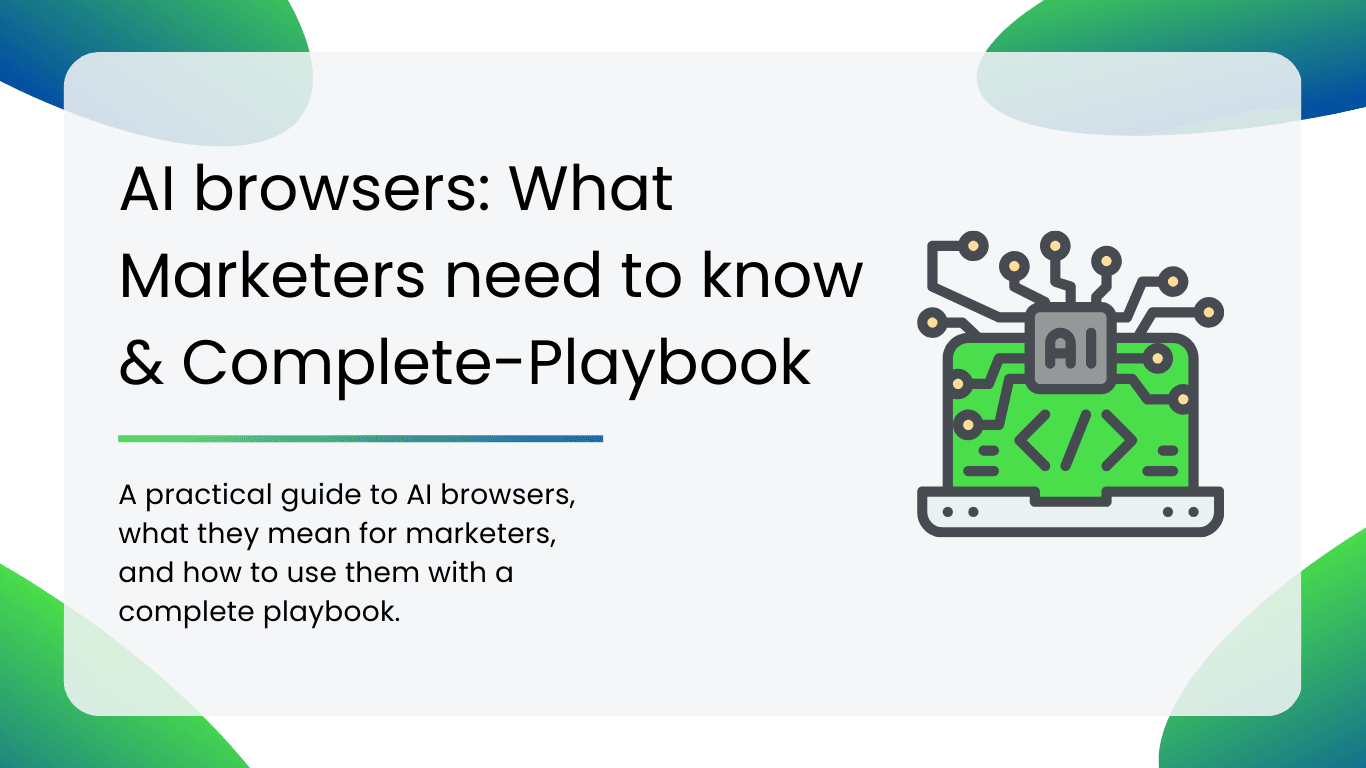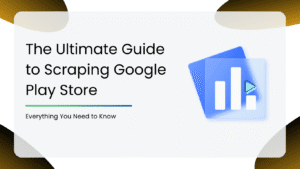AI browsers are rewiring the way people explore online, and for marketers, that means rethinking every part of their digital strategy. Instead of endless lists and cluttered ads, these browsers use advanced algorithms to pull together answers, recommend content, and even complete tasks on behalf of the users.
Now, browsing feels more personal, less noisy, and surprisingly more efficient. Brands that once relied on keyword placements or banner ads have to adjust to a world where value and clarity will win out over sheer volume. What’s more, AI browsers are built around privacy and smart decision-making, which means that the old tricks don’t always work.
With LLMs like ChatGPT, Gemini, and others driving how people find and use information, marketers have to move past the basics. Being visible isn’t just about higher ranking, but it’s about being the trusted solution. As this shift takes hold, digital marketing demands fresh content, true engagement, and a readiness to adapt to rapidly changing technologies.
How is AI Browser different from a Traditional Browser?
| AI Browser | Traditional Browser |
| Uses AI to summarize pages, answer questions, and give context without needing extra searches. | Loads websites as they are and leaves interpretation completely to the user. |
| Can automate tasks like filling forms, organizing tabs, or even comparing info across sites. | Only provides manual navigation and task execution. |
| Learns from user behavior to personalize search, suggestions, and workflows. | Offers basic personalization like bookmarks, history, and saved passwords. |
| Often integrates with AI assistants (chatbots, Copilot, Aria, Leo, etc.) for real-time help. | Relies on third-party extensions or search engines for added functionality. |
| Focused on productivity, reducing clicks, and keeping you inside the browser ecosystem. | Focused on browsing and displaying content with minimal automation. |
How AI Browsers are Shaping Marketing
- Competing for Shorter Attention: Condensed search results mean that brands must make every answer matter.
- Context Drives Relevance: AI browsers pick up on full site context, reviews, feedback, and holistic value instead of just the keywords.
- Prioritizing Trusted Sources: Brand answers get highlighted only if the content is reliable, fresh, and cited by authoritative sites.
- Features Interactive Tools: AI browsers showcase guides, calculators, and other useful features over static ads.
- Focusing on Genuine Engagement: Authentic user value stands out, reducing the impact of spammy or clickbait tactics.
Key Opportunities for Marketers
- Answering Real User Questions: Directly helpful content makes brands more visible in AI-generated results.
- Maintaining Trust with Freshness: Regular updates and positive reviews increase the chances of being recommended.
- Personalizing Experience: AI-driven personalization lets marketers connect with users individually.
- Joining Community Conversations: Active participation in niche forums and groups builds authentic relationships.
- Using Advanced Analytics: New tools reveal how content performs and evolves in AI browser rankings.
Top Challenges and Risks Facing Marketers
- Protecting User Privacy: Increased data collection raises real privacy concerns for both marketers and users.
- Guarding Against Security Flaws: Automated browsing can open doors to data leaks or malicious attacks.
- Navigating Fragmented Algorithms: Multiple browsers with unique ranking logic create mixed brand experiences.
- Adapting to Shifting Visibility Rules: Marketers need to regularly monitor changes to keep content discoverable.
- Keeping Brand Authenticity Intact: Overreliance on automation risks making brands feel less human and relatable.
1. Perplexity’s Comet
Comet is Perplexity’s new AI-powered browser that goes beyond showing links by answering questions and completing tasks for the users. It includes Comet Assistant, which can summarize emails, track browsing history, and even manage tabs so important info is never lost. You can ask it to find specific content using simple English, and it can compare options or do research automatically. For marketers, it means that users might not visit your site directly, but your content can still be selected and acted upon if it is AI-friendly and well-organized.
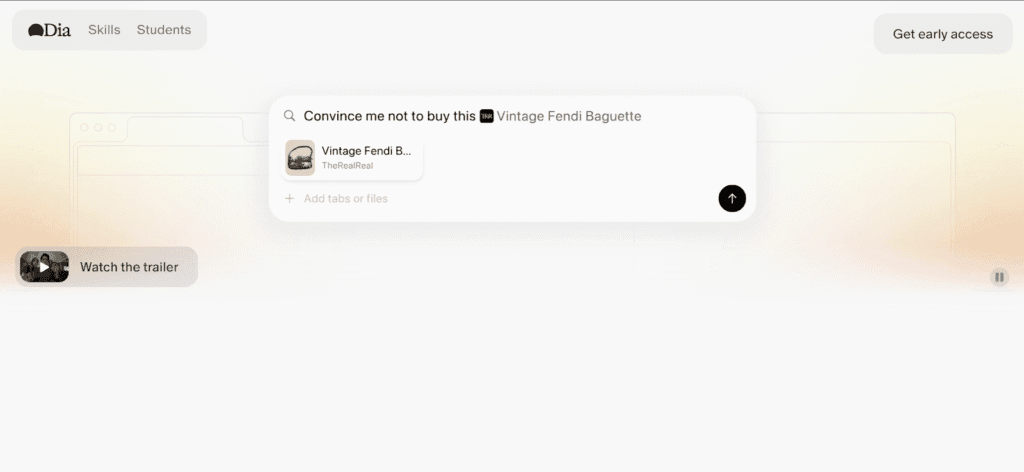
Key Features:
- AI-powered Task Automation: Built-in assistant completes tasks for users.
- Natural language Queries: Simple English is used to find content or reopen tabs.
- Intelligent Tab Management: Keeps browsing history organized and accessible anytime.
- Email & Calendar Summaries: Extracts key info from communications.
- AI-Generated Comparisons: Presents options and summaries for efficient decisions.
2. Dia
Dia focuses on ambient AI intelligence that works alongside users quietly but efficiently. It can take actions automatically, such as adding products from emails to shopping carts without any user intervention. Dia keeps all your data stored and encrypted locally for privacy. For businesses, this means that the customers can make purchases or gather information directly through the browser if your brand’s details are accessible to the AI.

Key Features
- Autonomous Action Execution: Performs user tasks like online shopping automatically.
- Local Data Encryption: Ensures privacy by storing data securely on the device.
- Seamless AI Integration: AI works quietly alongside browsing without any intrusion.
- Privacy-Focused Design: Protects user information throughout the interactions.
- Direct Service Interactions: Supports transactions and info gathering during browsing.
3. OpenAI Browser
OpenAI’s upcoming browser aims to compete with Chrome by deeply embedding AI functions. Rather than traditional browsing, it will let users interact directly with services such as travel, food, real estate, and retail via chat-style interfaces. This allows booking, ordering, or other transactions inside the browser without visiting external sites. Marketers must optimize their services to be AI-accessible for transactions and engagement.

Key Features
- Native Chat Interface: Allows conversational interaction with services inside the browser.
- Deep Service Integrations: Enables bookings and purchases without leaving the browser.
- Personalized AI Experiences: Customizes interactions based on user preferences.
- Enhanced Data Control: Focuses on privacy and secure data management.
4. Arc Browser
Arc stands as a browser for power users with innovative tab and window management. Now it adds AI features such as smarter navigation, saving and recalling browsing info through conversational commands. It is best at managing tab overload by letting users ask for content they viewed earlier and pulling it up instantly. Businesses benefit when their content is optimized for smooth AI retrieval and contextual use.

Key Features
- Conversational Navigation: Controls browsing and recalls info through chat commands.
- AI Tab Management: Reduces clutter by intelligently managing all open tabs.
- Context-Aware Browsing: Understands user context to pull relevant info quickly.
- Power User Interface: Designed for efficient and streamlined browsing.
- Intelligent Content Retrieval: Surfaces previously viewed pages on demand.
5. Brave AI Browser
Brave is improving its privacy-focused browser with AI tools that provide quick answers and smart automation while prioritizing user security. It delivers direct results and recommendations without invasive tracking. For marketers, this means they must emphasize clear, trustworthy content and maintain strong privacy practices to gain visibility in Brave’s AI ecosystem.
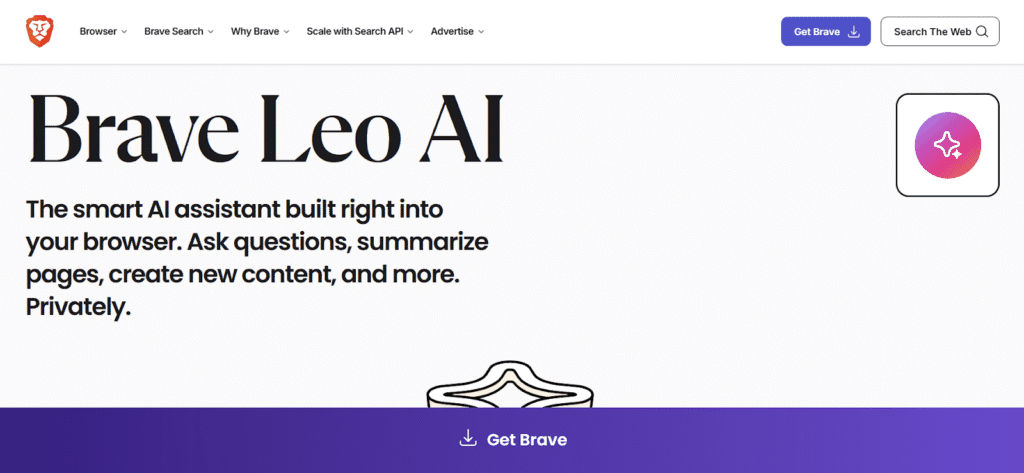
Key Features
- Privacy-First AI Delivery: Offers answers and recommendations with user privacy in mind.
- Automated Smart Suggestions: Provides helpful, timely content without tracking.
- Fast Direct Results: Cuts straight to the relevant user queries.
- Built-in Security Features: Includes measures against tracking and data misuse.
- User Privacy Controls: Let users manage their data and permissions.
Complete Playbook for Marketers
Step 1: Optimize for AI Readability
Make sure your website content is clear, organized, and uses correct schema markup. Add quick sections on service pages to help AI easily extract the key information. Use simple language and direct answers to common questions your audience might have.
Step 2: Create Conversational Content
Develop content that answers real user questions in a straightforward way. Use chat-friendly formats like FAQs, how-to guides, and step-by-step instructions. This helps AI browsers to pull your content as helpful answers.
Step 3: Ensure Seamless AI Interactions
Test your booking forms, contact pages, and other key functions to work without complex scripts or clicks. AI browsers need clean, accessible processes they can complete programmatically. Track AI referrers in analytics to see how the traffic flows.
Step 4: Build Trust with Frequent Updates
Update content regularly, add recent reviews, and fix any outdated information. AI browsers prefer trustworthy and current material when choosing what to display or act on.
Step 5: Engage in Niche Communities
Participate in forums, Q&A sites, and social platforms where your audience is active. Authentic conversations help build your brand and create backlinks and citations that AI browsers recognize.
Case Studies
1. LinkGraph’s Local SEO for Small Business Visibility
A small business drastically improved its online presence using a focused local SEO strategy powered by LinkGraph’s AI-driven services. The approach involved optimizing on-site elements for local relevance, building a quality local backlink profile, and optimizing Google Business Profile along with social signals. This strategy helped the business climb search rankings and improve its community engagement even as AI browsers began influencing local search. The ongoing monitoring with AI tools ensured adaptability to evolving search algorithms. Thus, securing sustained visibility and customer acquisition in a competitive market.
Key outcome: Enhanced local rankings, improved community engagement, and a strong foundation for emerging AI browser visibility.

2. Dia Browser Marketing: Transforming Customer Interaction
Dia Browser, an AI-native web browser, revolutionizes digital marketing by compressing the traditional user journey. Instead of just navigating multiple websites, users get direct, actionable answers and transactions within the browser itself. Brands making use of Dia’s platform adapt by delivering concise, value-driven content that is optimized for AI browser consumption, focusing on trust and transparency due to a privacy-first design. This shift significantly shortens the customer journey, requiring marketers to rethink visibility and engagement strategies customized specifically for AI browser ecosystems.
Key outcome: Marketers achieve direct conversions within AI browsers, bypassing traditional website visits while building trust through transparent communication.
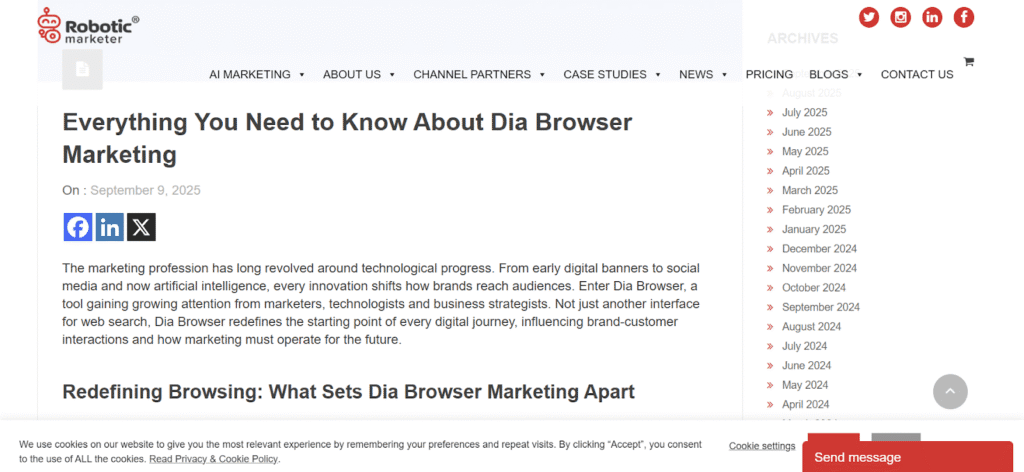
3. Xponent’s 4162% Traffic Growth Using AI SEO for AI Browser Rankings
Xponent21, an AI-focused marketing agency, engineered an SEO strategy targeting top AI browser platforms such as Perplexity, ChatGPT, and Google AI Mode. By integrating AI SEO tools, including semantic search optimization and AI-curated content strategies, Xponent21 boosted its organic traffic by over 4100% just within a year. This growth translated into top rankings specifically on AI browsers, showing the power of tailoring SEO for AI-driven search environments rather than traditional search engines alone.
Key Outcomes: 4162% increase in traffic driven by AI browsers through specialized AI SEO techniques
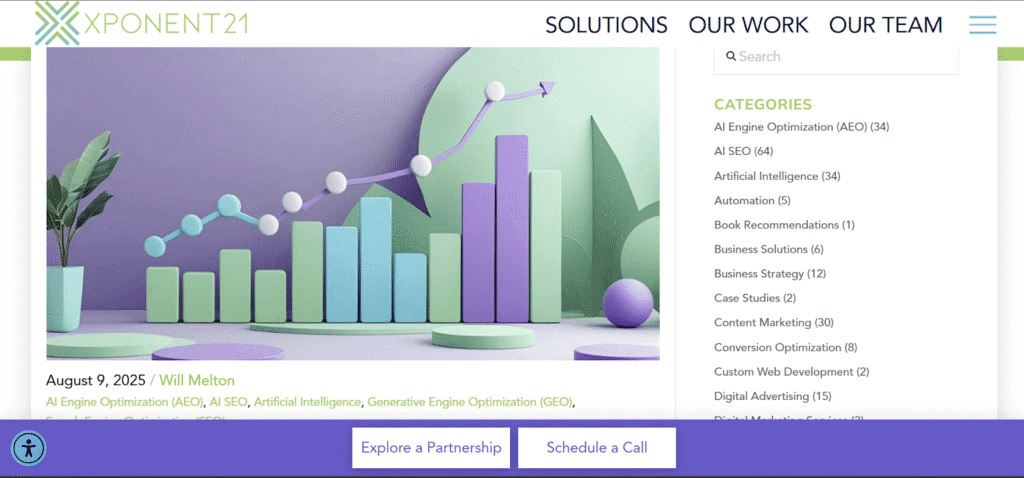
Conclusion
AI browsers are changing how people find and use online content, and marketers need to adapt quickly.
Instead of focusing only on search rankings, brands must become trusted sources that AI systems will turn to for answers and actions.
Clear, helpful content and seamless user experiences are now key to staying visible and relevant in 2025. Keeping information fresh and engaging with communities will build the trust that AI browsers require.
Marketers who prepare for this shift will connect better with their audiences and stay ahead in the changing digital world.
Check out our other blogs for more AI tools and insights
- Generative AI for SEO
- 16 Ways Artificial Intelligence Can Be Used in Marketing in 2021
- Best AI Productivity Tools in 2024
FAQs
An AI browser does more than just open websites. It can read pages, give quick answers, and even help with tasks like organizing tabs. A normal browser only shows the site and leaves everything to you.
AI browsers look for clear and trustworthy content, not just high rankings. If your website is easy to read, well-structured, and updated often, it has a better chance of being shown in AI browser results.
No, search engines will still exist. But AI browsers may cut down the number of searches people do because they give answers directly. Businesses need to be ready for both.
Keep your content clear and simple, use headings and structured data, update pages regularly, and make sure forms or booking systems work smoothly. This helps AI tools pick up your site more easily.

